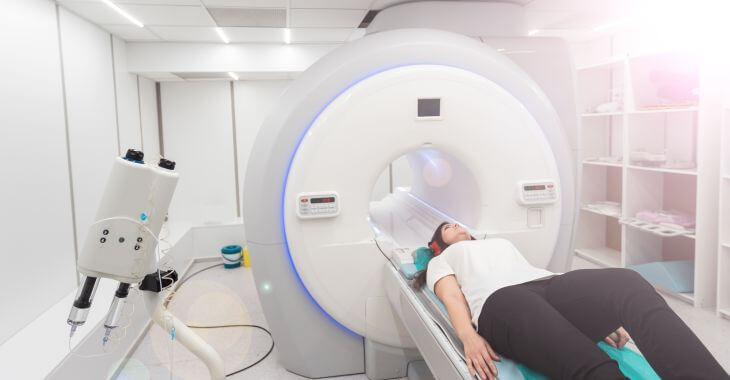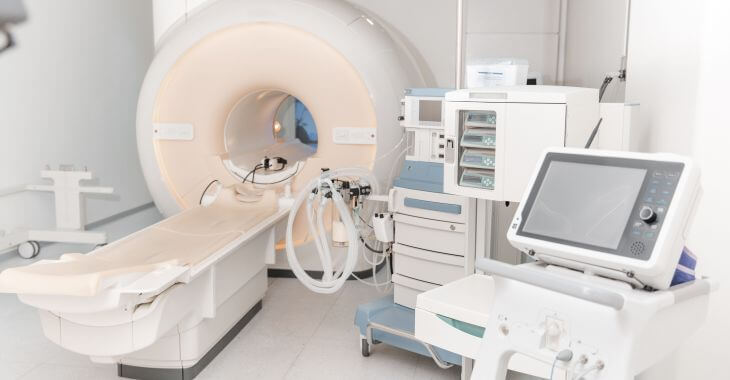How Long Does an MRI Take?

Imaging is one of the best options for diagnosing medical conditions. While x-rays and CT scans can be used for some areas in the body, others may require an MRI. If your doctor has recommended this form of imaging, you may be wondering, “How long does an MRI take?”
What Is an MRI?
Magnetic resonance imaging (MRI) is an advanced option for viewing internal tissues without the use of radiation. MRIs are often recommended for soft tissue areas and offer a more intricate view of non-boney material than x-rays or CT scans.
MRIs use powerful magnets combined with a computerized program that creates a cross-section of images. This type of imaging can show a detailed picture of various soft tissues to detect abnormities. Some of the body parts that may require an MRI include:
- Brain
- Internal organs
- Muscles, tendons and ligaments
- Joints
- Breasts
- Spinal cord and nervous system
When an MRI is performed, it can take more time than other forms of imaging. Why do MRIs take so long? This is due to the number of images taken to create the detailed 3D model of the targeted area. The process is very complex, but an MRI can offer incredible diagnostic benefits.
What Happens During an MRI?
To perform an MRI, the patient must be free from any metal, due to the powerful magnet used during the procedure. All jewelry, medical devices (eyeglasses or hearing aids) and clothing are to be removed. Due to the magnet, anyone with internal metal implants cannot have an MRI.
An MRI machine has a large table where the patient lies during the procedure. The table moves in and out of a tubular device where the images are taken. The amount of time needed to obtain the desired images depends on the size and complexity of the area scanned.
During the procedure, the MRI can be very loud while it performs various imaging tasks. Patients are often given ear plugs or headphones to reduce the noise. There is a microphone and speaker inside the MRI machine to allow the patient and medical staff to communicate.
The MRI procedure is not painful, but it can be uncomfortable for some people due to the process. The MRI tube can be confining, and some individuals may have claustrophobia or anxiety during the procedure. Sedatives can be used to relieve anxiety, or an “open” MRI may be needed.
Length of MRI Procedures
How long does an MRI take? It depends on what body area is being examined. An MRI can last from as little as 15 minutes up to 90 minutes. Imaging a small area like a single joint will take much less time than looking at the brain or spinal cord. An MRI of the brain is often one of the longer procedures.
How long does a brain MRI take? That depends on what the physician is looking for in the brain. Some brain MRIs require that a contrast or dye be added intravenously to create detailed images of the internal brain structures. This can add to the length of the procedure.
In most cases, a head or brain MRI can be performed in less than an hour. The procedure can be useful for identifying abnormalities such as aneurysms, tumors, infections, stroke damage, hemorrhaging and other brain conditions.
Why Do MRIs Take So Long?
Unlike other imaging like x-rays that just take a still picture of the internal structures, MRIs may include hundreds or more images. Cross-sectional imaging is used to create a 3-D image of the brain or other body parts for an intricate look at the structures inside.
Some of the longer MRIs are functional MRIs. On the brain, an MRI can be taken while the patient performs different tasks, showing changes in the brain when it is using different areas. This can require a much longer session than a typical MRI.
How Long Does It Take to Get MRI Results?
While the results of the MRI are computerized and readable right away, it may take several days or longer for patients to receive their results. The length of time depends on which medical professionals need to examine the images to come to a conclusion on the results.

For those undergoing a diagnosis for a complex condition, it may require multiple specialists to view and confer on the MRI results. Some patients may not hear back from their doctor for 1-2 weeks with the outcome. In emergency or urgent situations, patients may get MRI results the same day.
If your doctor orders an MRI, it will usually take 30-60 minutes or longer to perform and you may not receive your results the same day. However, MRIs can be a valuable diagnostic tool that can be helpful in determining the best treatment options for your health condition.
The information provided on this website, including text, graphics, images, and other materials, is intended solely for informational purposes and should not be used as a substitute for professional medical advice, diagnosis, or treatment.




)